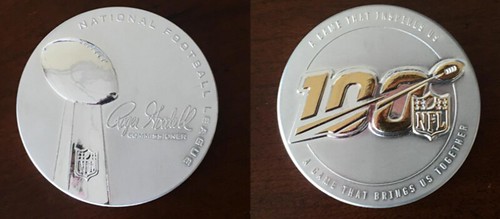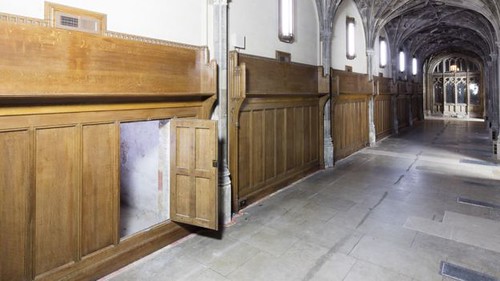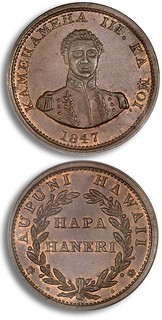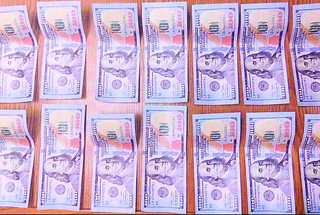
PREV ARTICLE
FULL ISSUE
PREV FULL ISSUE
LOOSE CHANGE: MARCH 1, 2020Here are some additional items in the media this week that may be of interest. -Editor NFL 100 Challenge Coin
 Sam Lombardo's Super Bowl LIV surprise didn't end with the final tick of the clock at Hard Rock Stadium on Feb. 2. On Tuesday, Lombardo's mail included an elegant coin and a heartfelt letter from National Football League Commissioner Roger Goodell, memorializing the retired Army lieutenant colonel's participation in the coin toss for the contest between the San Francisco 49ers and the Kansas City Chiefs. Lombardo was one of four 100-year-old World War II veterans chosen by the NFL to participate in the coin toss, to mark both the 75th anniversary of the end of that war, and the 100th year of the NFL. The thick silver coin, though not the official coin used for the game-day coin toss, features the NFL logo for its 100th anniversary offset in gold on one side, and the Super Bowl trophy and Goodell's signature on the other side. Around the NFL logo are the words "A Game That Inspires Us. A Game That Brings Us Together." To read the complete article, see:
Aloha to Hawaiian Coinage
Michael Garofalo published a nice survey article about Hawaiian Coinage in the Greysheet daily news. Here's a short excerpt - see the complete article online for much more. -Editor
It was agreed that 100,000 of these Keneta coins would be struck by H.M & E. I. Richards of Attleboro, MA. This company had struck a number of Hard Times tokens so they were respected private minters. The coins left the port of Boston on the merchant ship S.S. Montreal. The journey would leave Boston, sailing south down the eastern coast of America, south past Central America and skirt the east coast of South America. The ship made a planned stop at Rio de Janeiro and then sailed south coming around the tip of South America at Tierra del Fuego. Now the Montreal headed north along the coast of South America and then at Santiago, Chile, headed due west across the Pacific to Tahiti. That was the last stop before docking in Honolulu. But after five months on board the humid and wet ship, many of the copper coins were badly discolored. But that was not the worst discovery. The King's portrait was very disappointing as he was unrecognizable to his subjects. This certainly set these coins off on the wrong trajectory. It took a number of years before even a small number of the 100,000 coins were disbursed. More than 88,305 coins were eventually shipped out of Hawaii and scrapped. The Keneta experiment was not a rousing success then but today the coins are considered scarce and are valuable. To read the complete article, see:
Paying for one criminal activity with another
Now the Belmont County Sheriff's Department is asking residents to report any suspicious currency they receive. According to Sheriff David Lucas, his office received a complaint Thursday that a female prostitute was paid with counterfeit money and then assaulted after objecting to the payment being made with fake bills. "It was at a local motel," Lucas said, "trying to pay someone (for) one criminal activity with another criminal activity." To read the complete article, see:
Long-hidden Passageway Uncovered in Parliament
It's not numismatic, but interesting and fun nonetheless. If you haven't seen this story already, check out the long-hidden passageway uncovered in Parliament. -Editor  A forgotten passageway used by prime ministers and political luminaries - and closed up by Victorian labourers - has been uncovered in Parliament. Historians working on the renovation of the House of Commons found the lost 360-year-old passageway, hidden in a secret chamber. The doorway was created for the coronation of Charles II, in 1660, to allow guests access to a celebratory banquet in Westminster Hall, the building next to the modern day Commons chamber. It was used by generations of MPs and political notables, such as the diarist Samuel Pepys, as the main entrance to the Commons but was blocked up before being concealed within the thick walls of the ancient building. Dendrochronology testing revealed that the ceiling timbers above the little room dated from trees felled in 1659 - which tied in with surviving accounts that stated the doorway was made in 1660-61 for the coronation banquet of Charles II. To read the complete article, see:
Wayne Homren, Editor The Numismatic Bibliomania Society is a non-profit organization promoting numismatic literature. See our web site at coinbooks.org. To submit items for publication in The E-Sylum, write to the Editor at this address: whomren@gmail.com To subscribe go to: https://my.binhost.com/lists/listinfo/esylum All Rights Reserved. NBS Home Page Contact the NBS webmaster 
|

